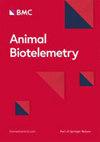座头鲸从南极觅食地到热带产仔地迁徙行为的首次描述
IF 2.5
3区 环境科学与生态学
Q2 BIODIVERSITY CONSERVATION
引用次数: 6
摘要
背景尽管座头鲸是世界上迁徙时间最长的物种之一,但座头鲸迁徙周期的一半仍未被研究。到目前为止,还没有任何研究能够持续描述座头鲸从觅食地到产仔地的迁徙行为。我们提供了16头繁殖种群G座头鲸从南极觅食地到南美产仔地的卫星衍生离岸迁徙的新信息。卫星位置用于展示迁徙走廊,而出发日期对迁徙速度的影响则使用线性回归进行评估。利用贝叶斯层次状态-空间动物运动模型(HSSM)来研究途中区域限制搜索(ARS)的存在。结果从2012年至2017年,共收集了16头标记鲸的35642个Argos位置。对这16头鲸鱼进行了平均38.5天(10-151天)的迁徙追踪。单独衍生的轨道长度从645公里到6381公里不等。座头鲸在迁徙的初期和中期在地理上广泛分布,但在智利最南端附近的两个交汇区以及秘鲁的伊利斯卡斯半岛聚集。状态-空间模型几乎没有显示迁徙路线上的ARS实例。评估出发日期是否影响迁移速度的线性回归显示,这两个变量之间的积极趋势得到了暗示但不确定的支持。在出发日期和路线选择方面,发现了按性别和生殖状况进行分层的结果。结论这项多年研究为气候变化对座头鲸的影响设定了一个基线,可以根据该基线在不同年份和条件下进行研究,并为座头鲸迁徙调查提供了一个良好的起点。本文章由计算机程序翻译,如有差异,请以英文原文为准。
First description of migratory behavior of humpback whales from an Antarctic feeding ground to a tropical calving ground
Background Despite exhibiting one of the longest migrations in the world, half of the humpback whale migratory cycle has remained unexamined. Until now, no study has provided a continuous description of humpback whale migratory behavior from a feeding ground to a calving ground. We present new information on satellite-derived offshore migratory movements of 16 Breeding Stock G humpback whales from Antarctic feeding grounds to South American calving grounds. Satellite locations were used to demonstrate migratory corridors, while the impact of departure date on migration speed was assessed using a linear regression. A Bayesian hierarchical state–space animal movement model (HSSM) was utilized to investigate the presence of Area Restricted Search (ARS) en route. Results 35,642 Argos locations from 16 tagged whales from 2012 to 2017 were collected. The 16 whales were tracked for a mean of 38.5 days of migration (range 10–151 days). The length of individually derived tracks ranged from 645 to 6381 km. Humpbacks were widely dispersed geographically during the initial and middle stages of their migration, but convened in two convergence regions near the southernmost point of Chile as well as Peru’s Illescas Peninsula. The state–space model showed almost no instances of ARS along the migratory route. The linear regression assessing whether departure date affected migration speed showed suggestive but inconclusive support for a positive trend between the two variables. Results suggestive of stratification by sex and reproductive status were found for departure date and route choice. Conclusions This multi-year study sets a baseline against which the effects of climate change on humpback whales can be studied across years and conditions and provides an excellent starting point for the investigation into humpback whale migration.
求助全文
通过发布文献求助,成功后即可免费获取论文全文。
去求助
来源期刊

Animal Biotelemetry
Agricultural and Biological Sciences-Animal Science and Zoology
CiteScore
4.20
自引率
11.10%
发文量
33
审稿时长
10 weeks
期刊介绍:
Animal Biotelemetry is an open access peer-reviewed journal that publishes the results of studies utilizing telemetric techniques (including biologgers) to understand physiological, behavioural, and ecological mechanisms in a broad range of environments (e.g. terrestrial, freshwater and marine) and taxa. The journal also welcomes descriptions and validations of newly developed tagging techniques and tracking technologies, as well as methods for analyzing telemetric data.
 求助内容:
求助内容: 应助结果提醒方式:
应助结果提醒方式:


